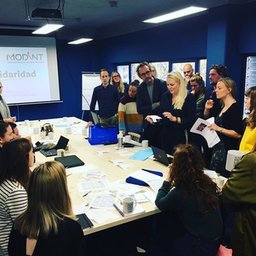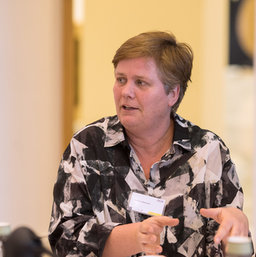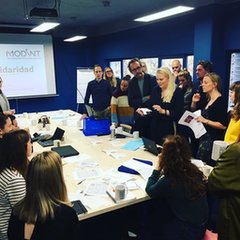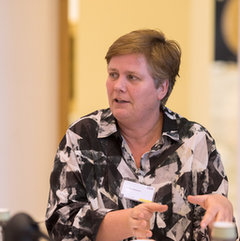Convenant:
Current situation
Because the available information and a company’s experience increase over time, the goals can be made increasingly refined. The process of due diligence is therefore continuously being worked through and improved.
The Agreement in brief
The Dutch Agreement on Sustainable Garments and Textile is supported by a growing coalition of companies, sector organisations, trade unions, national government, civil-society organisations (NGOs), and expert organisations. The goal is that in 2020, at least 80 per cent of the Dutch garments and textile sector will have signed the Agreement.
With their signatures, participants declare their commitment to the goals of the Agreement, which involve working for better labour conditions and dealing appropriately with animals and the environment. Companies undertake to investigate their chain to define the risks of being involved in abuses in the areas of human rights, the environment and animal welfare, and how they can deal with such risks. This is done through due diligence according to the OECD guidelines: drawing up RBC policy, analysis of the chain, risk analysis and prioritisation, tackling the risks, and access to remedial action, monitoring and communication.
Moving forwards step by step
In the course of the Agreement, participating companies are expected to keep taking further steps. We have now reached year 3.
- Year 1: companies gain a clear picture of their production chain and make a list of production sites, which the Secretariat adds to the aggregated list. In addition, companies draw up an action plan in which they investigate the risks in their chain and set priorities. They also identify specific, achievable goals for tackling the risks.
- Year 2: companies start to implement their action plan, in cooperation with trade unions, civil-society organisations, and government. They produce a progress report each year. Because the available information and a company’s experience increase over time, the goals can be made increasingly refined. The process of due diligence is therefore continuously being worked through and improved.
- Year 3: companies communicate their action plan to the outside world. On their website and in annual reports, they explain their risks and how they deal with them.
Results achieved in 2018
- Expansion of production site list: from 2802 production sites (end-2017) to 4268 (end-2018). Result: greater transparency in the chain.
- Rise in the number of participating brands to 92, which represents 48% of the Dutch market.
Result: greater joint influence both in the Netherlands and internationally. - Greater understanding of materials used in the sector.
Result: more informed choices lead to a switch to using more sustainable materials. - Setting up and carrying out collective projects, training courses, workshops and tools.
Result: more knowledge and skills for enhancing sustainability of processes and products. - Introduction of assessment framework for action plans.
Result: learning together, giving companies practical help, and joint action. - Assessmentof the action plansby the Secretariat; Facts & figures.
Result: greater transparency regarding joint progress. - More international cooperation with other initiatives, such as the German partnership, the Fair Labour Association (FLA), and the Sustainable Apparel Coalition (SAC).
Result: cooperation strengthens collective influence and international support.
Workshop Solidaridad and Modint
Solidaridad and Modint give tips for making the purchasing process more sustainable

Due diligence begins with the identification of risks. But what is the next step? In 2018, international development organisation Solidaridad, Modint – the trade association for fashion, interior design, carpets, and textiles – and the Agreement’s Secretariat organised two workshops in which companies were given practical tips for improving the sustainability of their purchasing practices.
‘Companies that have conducted a risk analysis are keen to solve all the issues that emerged from the due diligence,’ says Tamar Hoek, textile programme manager at Solidaridad. ‘During the workshops, we gave them tips for starting close to home: with their own purchasing process.’
According to Hoek, some measures can be taken relatively quickly and easily. ‘For example, set the latest date by which a design can be modified and stick to it. It’s understandable that companies want to get something that is trendy into the shops as quickly as possible, but this can mean that suppliers – and therefore the factory workers – are obliged to do a lot of overtime. Therefore, as a company you can do something about that.’
At Solidaridad and Modint’s request, two people from each company came to the workshops: one RBC manager and one buyer. ‘Each of them has different objectives within their company and it is therefore a good idea to discuss things with them together. Thanks to the workshops, we’ve gained a clearer picture of the internal workings within companies. And we have had a lot of positive feedback from the participants. The sessions have really had an impact within companies.’
Sandra Claassen, directeur Arisa:
‘It takes courage to be transparent’

For the non-governmental organisation Arisa (previously Landelijke India Werkgroep [India Committee of the Netherlands]), it was a major step to sign the Dutch Agreement on Sustainable Garments and Textile. But Arisa has not regretted its participation, although director Sandra Claassen has had to revise her expectations.
What is your view on the progress of the Agreement?
‘In the first years, it was quite a tough task to set up the procedures, the due diligence process, and monitoring. We thought that once companies had presented their action plans, lists of priorities would quickly be produced and we would tackle them together. But it’s all a bit more complicated and time-consuming, and as a result, we’ve had to revise our expectations. Due diligence is something new for many companies. It turns out to be a considerable effort for a company to gain a clear picture of its own production chain, and then it still has to start on the risk analysis.’
Are you satisfied with the results?
‘One would prefer to be able immediately to present specific results and hard figures to the outside world. But it all starts with mutual trust and cooperation. In many cases, civil-society organisations, trade unions, and companies do not yet know one another. There are prejudices on all sides. We don’t speak each other’s language. Thanks to the Agreement, we get to know one another better and grow in confidence to do something together against the abuses in the sector.
It’s fascinating to work with companies. At the end of 2017, for example, we launched a project together with four garment companies to improve working conditions in spinning mills in South India. Through such a project, we as NGOs, trade unions, and companies come to know more about each other and also gain respect for one another.
Companies know about the production chain in particular. They mainly have contact with suppliers and company management. Their information is based on audits. NGOs and trade unions have relationships with local partners and know what goes on behind the scenes of the production process. By pooling this knowledge and experience, we can have influence and possibly also bring about change. We can help companies, for example, to use the results of audits to ask more probing questions, so that problems that do not emerge from an audit are also made visible.’
Can you still be critical as a party to the Agreement?
‘We were hesitant about signing the Agreement, wondering whether the agreements went far enough for us. The agreements about transparency, the complaints mechanism, and the fact that risks deeper in the chain are also addressed were very important to us. On that basis, we concluded that it is good to help others think about the issues and to initiate a dialogue within the Agreement. Other NGOs reached a different conclusion. They continue to challenge, ask questions, and push from the outside, and that’s fine, too.
We are just continuing to do what we were set up for. We regularly publish critical reports about a sector or companies that are active in South Asia. We do this to get a sector moving, so that it takes responsibility and tackles violations. Our aim is not to blacken a company’s name. If we have criticism, we have well-founded reasons for it, as otherwise we would lose our credibility. I can understand that companies don’t like being criticised. On the other hand, those are the companies that read our reports meticulously. IRBC policy is pushed higher up their list of priorities.’
Has the Agreement made you think differently about companies?
‘We’ve gained a better understanding of where companies have got to with their due diligence. There are big differences in the extent to which companies integrate IRBC into their policy. I see that many companies in the Agreement look beyond the bottom line and have the intention of improving their company. But this cannot be achieved from one day to the next. There are no ready-made solutions to social issues such as women’s rights, forced labour and child labour, or issues relating to animal welfare and the environment. If there are abuses at a factory, it is not a solution to just up and leave. It’s more important to enter into a discussion, so that the situation will improve for workers in the factory, for the environment, and for animal welfare.’
What role do NGOs play in the Agreement?
‘We’ve learned that we don’t have to wait for companies to come to us with a question or a problem. We need to be proactive, initiate discussions with companies, tell them what we do, and explain what added value we can bring to companies. For example, if we receive complaints from our local partner organisations about a production site that is on the list, we try, through the Secretariat, to make contact with the company that has a relationship with that production site. We then consider together how to tackle the problem. A company’s impact is often limited, particularly if it’s one of many buyers from that factory, and perhaps only a minor one. But when we put a company in touch with our local partner organisations, it sometimes leads to a change for the better, nevertheless.’
Why do you think transparency is so important?
‘Transparency is necessary in order to gain insight into risks and actual violations. Transparency gives confidence, as problems are not denied. I understand that it’s difficult for companies to show vulnerability. They’re afraid to let others see that mistakes are made in the chain and that they’re wrestling with these problems. For this reason, I have a lot of respect for a company that communicates openly about its IRBC dilemmas.
Companies that are transparent run the risk of attracting a lot of criticism. After all, attention is always focused on those who speak up, not those who remain silent. Companies that are party to the Agreement therefore have to have a lot of guts. Transparency isn’t easy, but it’s necessary in order to get the ball rolling on change. Not only at the companies that are party to the Agreement, but throughout the sector, the Netherlands and the world.
No company is perfect. Everyone makes mistakes, including us. But if you’re transparent about what you do, it means you let others look at your activities. And those others may be able to help you find a solution.’

